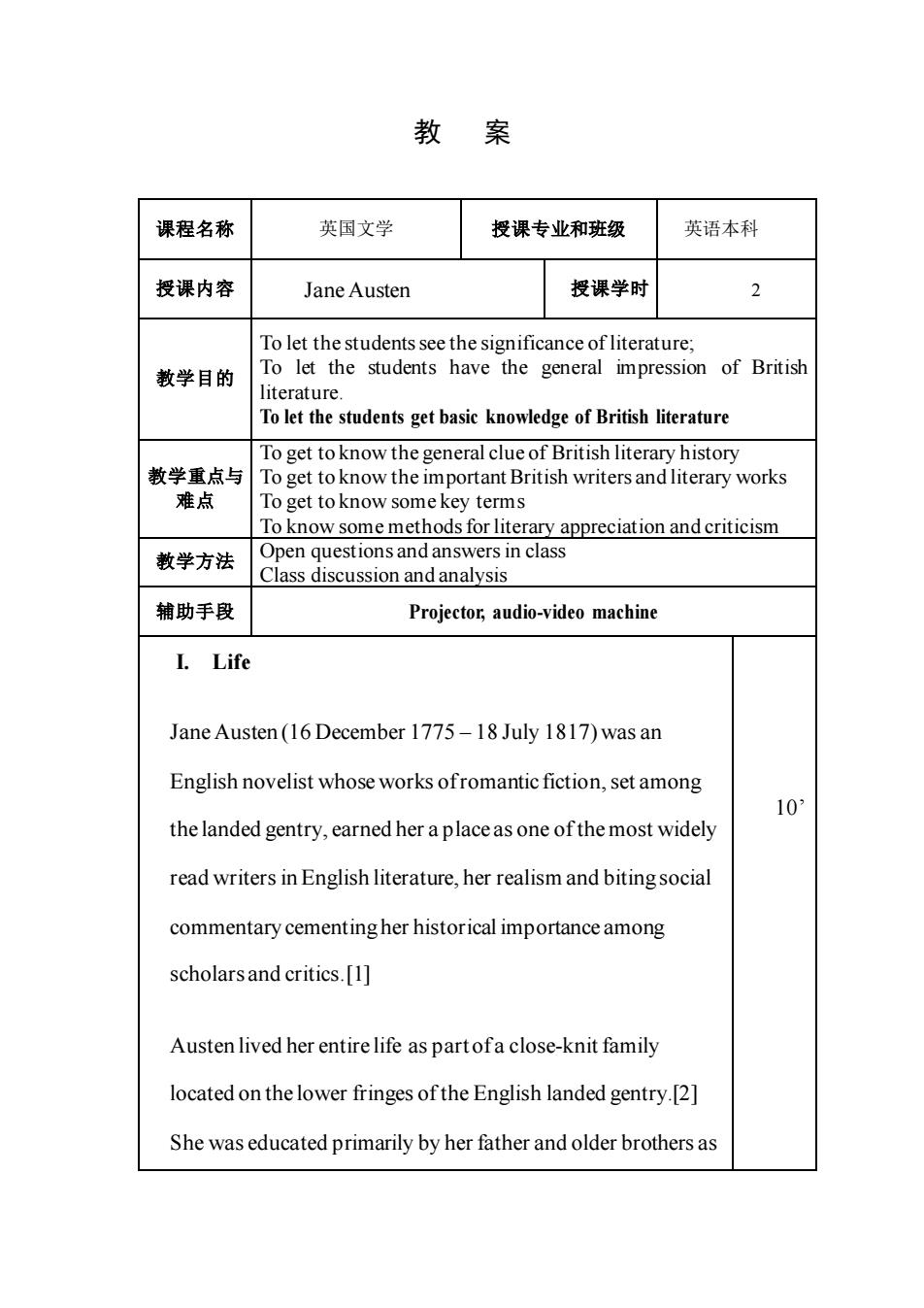
教案 课程名称 英国文学 授课专业和班级 英语本科 授课内容 Jane Austen 授课学时 To let the students see the significance of literature; 教学目的 To let the students have the general impression of British literature. To get to know the general clue of British literary history 教学重点与To get to know the important British writers and literary works 难点 To get to know some key terms To know some methods for literary appreciation and criticism 教学方法 Open questions and answers in class Class discussion and analysis 辅助手段 Projector,audio-video machine I.Life Jane Austen(16 December 1775-18 July 1817)was an English novelist whose works ofromantic fiction,set among 10 the landed gentry,earned her aplaceas one ofthe most widely read writers in English literature,her realism and biting social commentary cementing her historical importance among scholarsand critics.[1] Austen lived her entire life as partofa close-knit family located on thelower fringes ofthe English landed gentry.[2] She was educated primarily by her father and older brothers as
教 案 课程名称 英国文学 授课专业和班级 英语本科 授课内容 Jane Austen 授课学时 2 教学目的 To let the students see the significance of literature; To let the students have the general impression of British literature. To let the students get basic knowledge of British literature 教学重点与 难点 To get to know the general clue of British literary history To get to know the important British writers and literary works To get to know some key terms To know some methods for literary appreciation and criticism 教学方法 Open questions and answersin class Class discussion and analysis 辅助手段 Projector, audio-video machine I. Life Jane Austen (16 December 1775 – 18 July 1817) was an English novelist whose works of romantic fiction, set among the landed gentry, earned her a place as one of the most widely read writers in English literature, her realism and biting social commentary cementing her historical importance among scholars and critics.[1] Austen lived her entire life as part of a close-knit family located on the lower fringes of the English landed gentry.[2] She was educated primarily by her father and older brothers as 10’
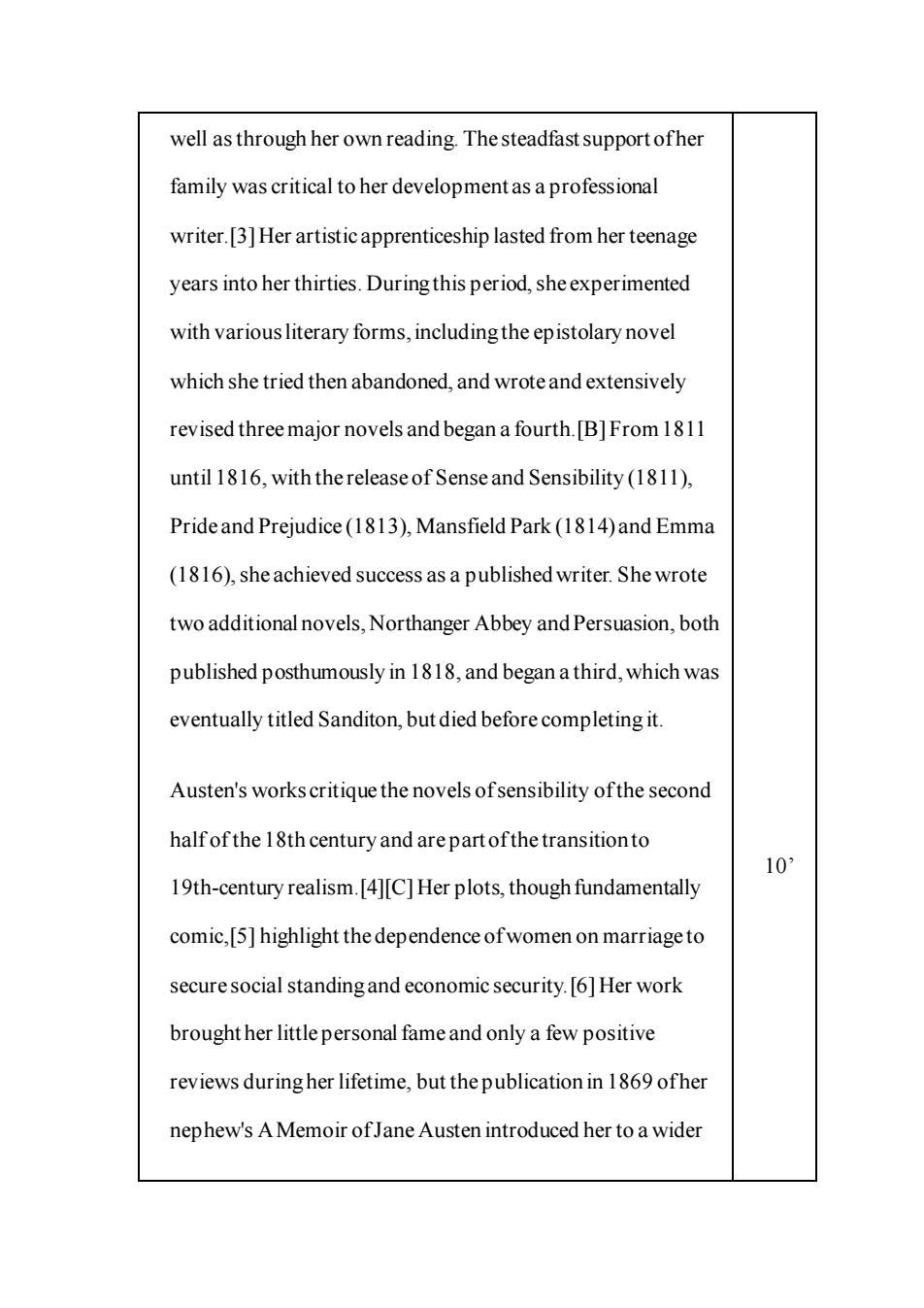
well as through her own reading.The steadfast support ofher family was critical to her development as a professional writer.3]Her artisticapprenticeship lasted from her teenage years into her thirties.During this period,sheexperimented with various literary forms,including the epistolary novel which she tried then abandoned,and wroteand extensively revised three major novels and began a fourth.[B]From 1811 until 1816,with the release of Sense and Sensibility(1811), Prideand Prejudice(1813),Mansfield Park(1814)and Emma (1816),sheachieved success as a published writer.She wrote two additional novels,Northanger Abbey and Persuasion.both published posthumously beganathird,which was eventually titled Sanditon,but died before completing it. Austen's works critique the novels ofsensibility ofthe second half of the 18th century and are part ofthe transitionto 10 19th-century realism.[4][C]Her plots,though fundamentally comic,[5]highlight the dependence ofwomen on marriage to secure social standing and economic security.[6]Her work brought her little personal fame and only a few positive reviews duringher lifetime,but thepublication in 1869ofher nephew's A Memoir of Jane Austen introduced her to a wider
well as through her own reading. The steadfast support of her family was critical to her development as a professional writer.[3]Her artistic apprenticeship lasted from her teenage years into her thirties. During this period, she experimented with various literary forms, including the epistolary novel which she tried then abandoned, and wrote and extensively revised three major novels and began a fourth.[B] From 1811 until 1816, with the release of Sense and Sensibility (1811), Pride and Prejudice (1813), Mansfield Park (1814) and Emma (1816), she achieved success as a published writer. She wrote two additional novels, Northanger Abbey and Persuasion, both published posthumously in 1818, and began a third, which was eventually titled Sanditon, but died before completing it. Austen's works critique the novels of sensibility of the second half of the 18th century and are part of the transition to 19th-century realism.[4][C]Her plots, though fundamentally comic,[5] highlight the dependence of women on marriage to secure social standing and economic security.[6]Her work brought her little personal fame and only a few positive reviews during her lifetime, but the publication in 1869 of her nephew's A Memoir of Jane Austen introduced her to a wider 10’
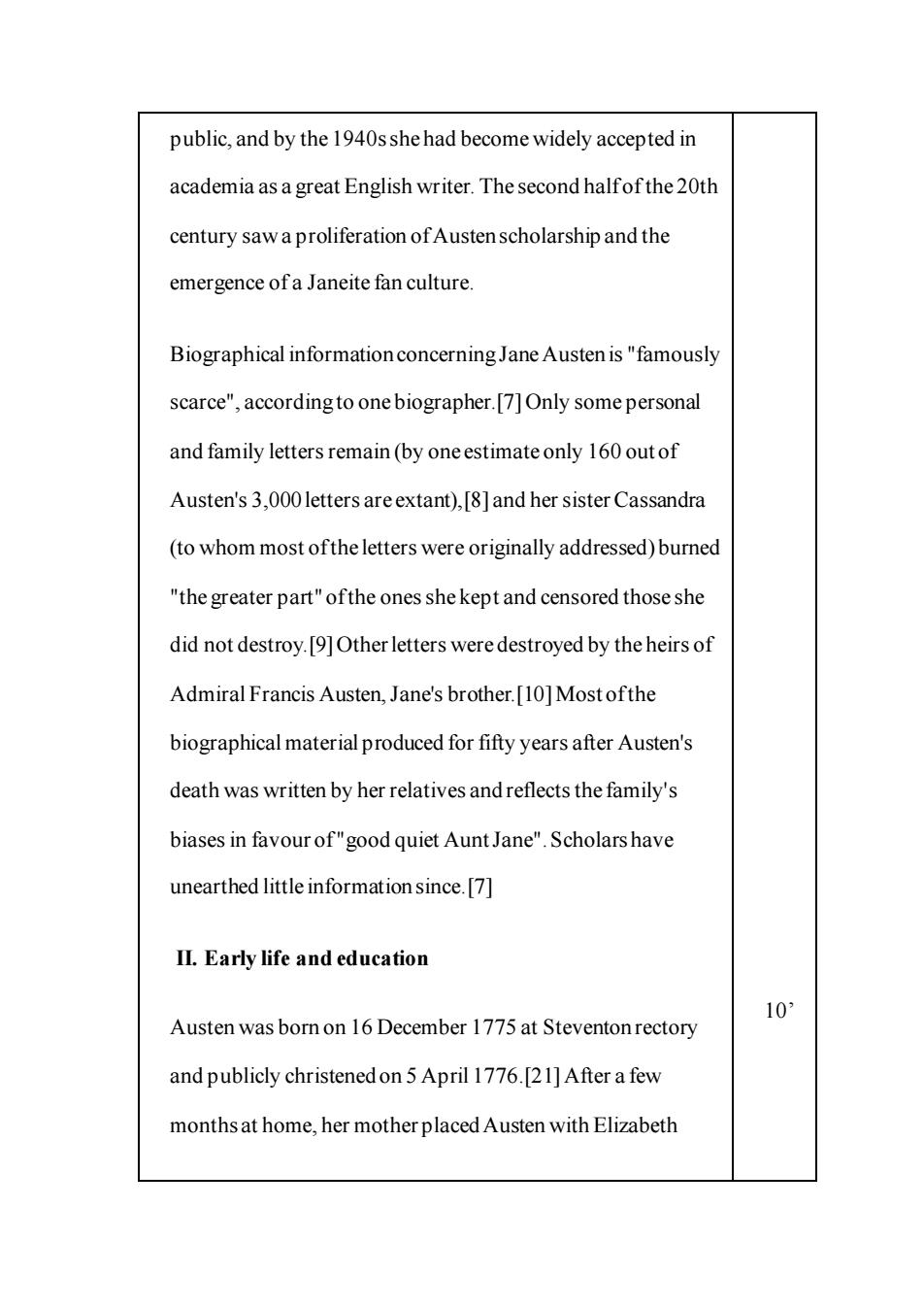
public,and by the 1940sshe had become widely accepted in academia as a great English writer.The second halfofthe 20th century saw a proliferation ofAustenscholarship and the emergence ofa Janeite fan culture Biographical informationconcerning Jane Austen is"famously scarce",according to one biographer.[7]Only some personal and family letters remain(by one estimate only 160 out of Austen's 3,000 letters are extant),[8]and her sister Cassandra (to whom most ofthe letters were originally addressed)burned "the greater part"ofthe ones she kept and censored those she did not destroy.[9]Other letters were destroyed by the heirs of Admiral Francis Austen,Jane's brother.[10]Most ofthe biographical material produced for fifty years after Austen's death was written by her relatives and reflects the family's biases in favour of"good quiet Aunt Jane".Scholars have unearthed little information since.[7] II.Early life and education Austen was born on 16 December 1775 at Steventon rectory 0. and publicly christened on 5 April 1776.[21]After a few months at home,her mother placed Austen with Elizabeth
public, and by the 1940s she had become widely accepted in academia as a great English writer. The second half of the 20th century saw a proliferation of Austen scholarship and the emergence of a Janeite fan culture. Biographical information concerning Jane Austen is "famously scarce", according to one biographer.[7]Only some personal and family letters remain (by one estimate only 160 out of Austen's 3,000 letters are extant),[8] and her sister Cassandra (to whom most of the letters were originally addressed) burned "the greater part" of the ones she kept and censored those she did not destroy.[9]Other letters were destroyed by the heirs of Admiral Francis Austen, Jane's brother.[10]Most of the biographical material produced for fifty years after Austen's death was written by her relatives and reflects the family's biases in favour of "good quiet Aunt Jane". Scholars have unearthed little information since.[7] II. Early life and education Austen was born on 16 December 1775 at Steventon rectory and publicly christened on 5 April 1776.[21] After a few months at home, her mother placed Austen with Elizabeth 10’
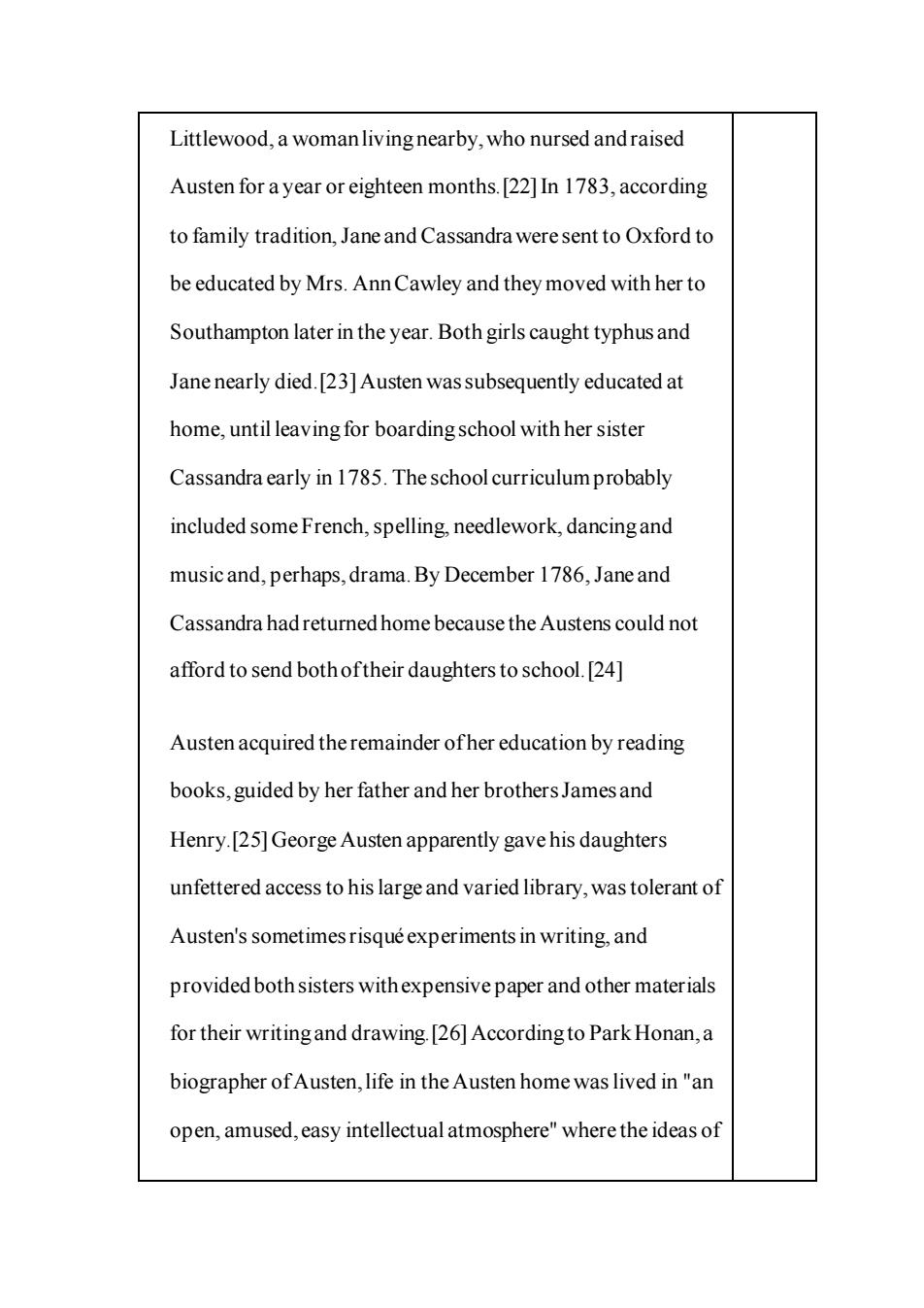
Littlewood,a womanliving nearby,who nursed andraised Austen for a year or eighteen months.[22]In 1783,according to family tradition,Jane and Cassandra were sent to Oxford to be educated by Mrs.Ann Cawley and they moved with her to Southampton later in the year.Both girls caught typhus and Jane nearly died.[23]Austen wassubsequently educated at home,until leaving for boarding school with her sister Cassandra early in 1785.The school curriculum probably included some French,spelling,needlework,dancingand music and,perhaps,drama.By December 1786,Jane and Cassandra had returned home because the Austens could not afford to send both oftheir daughters to school.[24] Austen acquired the remainder ofher education by reading books,guided by her father and her brothers Jamesand Henry.[25]George Austen apparently gave his daughters unfettered access to his large and varied library,was tolerant of Austen's sometimesrisque experiments in writing,and provided both sisters withexpensive paper and other materials for their writing and drawing.[26]Accordingto Park Honan,a biographer ofAusten,life in the Austen home was lived in"an open,amused,easy intellectual atmosphere"where the ideas of
Littlewood, a woman living nearby, who nursed and raised Austen for a year or eighteen months.[22]In 1783, according to family tradition, Jane and Cassandra were sent to Oxford to be educated by Mrs. Ann Cawley and they moved with her to Southampton later in the year. Both girls caught typhus and Jane nearly died.[23]Austen was subsequently educated at home, until leaving for boarding school with her sister Cassandra early in 1785. The school curriculum probably included some French, spelling, needlework, dancing and music and, perhaps, drama. By December 1786, Jane and Cassandra had returned home because the Austens could not afford to send both of their daughters to school.[24] Austen acquired the remainder of her education by reading books, guided by her father and her brothers James and Henry.[25]George Austen apparently gave his daughters unfettered access to his large and varied library, was tolerant of Austen's sometimes risqué experiments in writing, and provided both sisters with expensive paper and other materials for their writing and drawing.[26] According to Park Honan, a biographer of Austen, life in the Austen home was lived in "an open, amused, easy intellectual atmosphere" where the ideas of
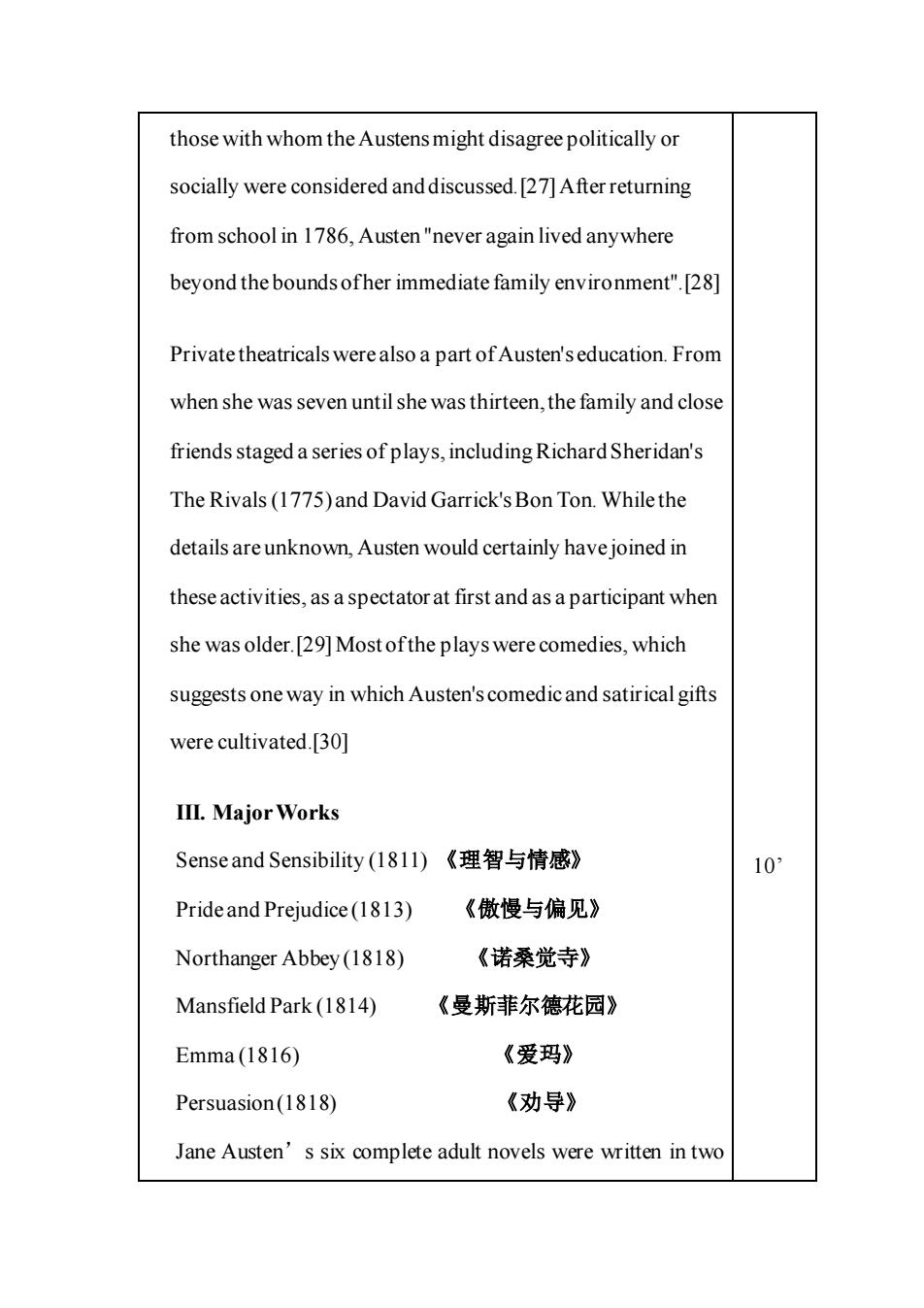
those with whom the Austens might disagree politically or socially were considered and discussed.[27]After returning from school in 1786,Austen"never again lived anywhere beyond the bounds ofher immediate family environment".[28] Private theatricals were also a part ofAusten'seducation.From when she was seven until she was thirteen,the family and close friends staged a series of plays,including Richard Sheridan's The Rivals(1775)and David Garrick's Bon Ton.While the details are unknown,Austen would certainly have joined in these activities,as a spectator at first and as a participant when she was older.[29]Most ofthe plays were comedies,which suggests one way in which Austen's comedicand satirical gifts were cultivated.[30] III.Major Works Senseand Sensibility(I8ll)《理智与情感》 10 Prideand Prejudice(1813) 《傲慢与偏见》 Northanger Abbey(1818) 《诺桑觉寺》 Mansfield Park(1814) 《曼斯菲尔德花园》 Emma(1816) 《爱玛》 Persuasion(1818) 《劝导》 Jane Austen's six complete adult novels were written in two
those with whom the Austens might disagree politically or socially were considered and discussed.[27]After returning from school in 1786, Austen "never again lived anywhere beyond the bounds of her immediate family environment".[28] Private theatricals were also a part of Austen's education. From when she was seven until she was thirteen, the family and close friends staged a series of plays, including Richard Sheridan's The Rivals (1775) and David Garrick'sBon Ton. While the details are unknown, Austen would certainly have joined in these activities, as a spectator at first and as a participant when she was older.[29]Most of the plays were comedies, which suggests one way in which Austen's comedic and satirical gifts were cultivated.[30] III. Major Works Sense and Sensibility (1811) 《理智与情感》 Pride and Prejudice (1813) 《傲慢与偏见》 Northanger Abbey (1818) 《诺桑觉寺》 Mansfield Park (1814) 《曼斯菲尔德花园》 Emma (1816) 《爱玛》 Persuasion (1818) 《劝导》 Jane Austen’s six complete adult novels were written in two 10’